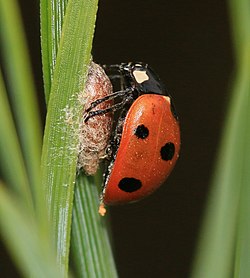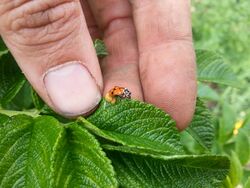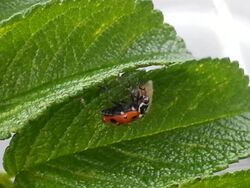Biology:Dinocampus coccinellae
| Dinocampus coccinellae | |
|---|---|

| |
| Scientific classification | |
| Kingdom: | |
| Phylum: | |
| Class: | |
| Order: | |
| Family: | |
| Subfamily: | |
| Genus: | Dinocampus
|
| Species: | D. coccinellae
|
| Binomial name | |
| Dinocampus coccinellae | |
| Synonyms [2] | |
| |
Dinocampus coccinellae is a braconid wasp parasite of coccinellid beetles, including the spotted lady beetle, Coleomegilla maculata. D. coccinellae has been described as turning its ladybird host into a temporary "zombie" guarding the wasp cocoon. About 25% of Coleomegilla maculata recover after the cocoon they are guarding matures, although the proportion of other ladybird species which recover is much lower.[3]
Description
In 1802, Schrank first described a female adult of this species as "Lady-bird killer 2155. Deep black, eyes green; head, front legs, and apex of the petiolate abdomen mussel-brown."[2] (A petiolate abdomen is one whose basal segment is stalk-like, that is, long and slender.) Nearly all D. coccinellae are female offspring of unfertilized eggs, although males are also occasionally found.[4] The male, when observed, has no ovipositor and is slimmer and darker than females.[5]
Biology
The mature female wasp seeks out adult female ladybirds, although they will sometimes oviposit into a male adult or larval instar.[4][6] One egg is planted in the host's soft underbelly. The wasp larva hatches after 5–7 days into a first instar larva with large mandibles and proceeds to remove any other eggs or larvae before beginning to feed on the ladybird's fat bodies and gonads.[7]
The wasp larva inside the ladybird goes through four larval instars in 18–27 days.[7] Meanwhile, the ladybird continues to forage and feed until the wasp larva, when it is ready to emerge, paralyzes the ladybird before tunneling out.[8] It pupates in a cocoon attached to the leg of the living ladybird, whose brightly colored body and occasional twitching reduce predation.[9] A growing D. coccinellae wasp nestled in its cocoon is extremely vulnerable, and other insects will devour it. If one of these predators tries to eat it, the ladybird retaliates, scaring it off. The ladybird becomes the parasite's bodyguard, by protecting it from predators.[10] However, wasp cocoons protected in this way develop into adults that produce fewer eggs, due to the energy demands of maintaining a living protector.[11]
Ladybirds paralyzed, twitching, and attached to the cocoon of D. coccinellae have been compared to zombies by many writers.[11][12][13] After 6–9 days, the wasp emerges from the cocoon.[7] Remarkably, some 25% of ladybirds revive and emerge from paralysis once the cocoon has been emptied.[11] The paralytic effect has been proposed to be associated with an RNA virus, Dinocampus coccinellae paralysis virus.[14][15]
Ecology
Dinocampus coccinellae can itself be parasitised by Gelis agilis, a hyperparasite that is known for its mimicry of ants. The wingless females of G. agilis oviposit into D. coccinellae cocoons; the egg immediately hatches and consumes the developing wasp. Cocoons hosting G. agilis usually take twice as long to emerge.[citation needed]
Economic importance
Because one large aphidophagous ladybird can consume up to 5,500 aphids in a year, any ladybird parasite represents a potential threat to agriculture.[7]
References
- ↑ "Dinocampus coccinellae (Schrank 1802)". Fauna Europaea. http://www.faunaeur.org/full_results.php?id=338557.
- ↑ 2.0 2.1 Cushman, R. A. (1922). "The identity of Ichneumon coccinellae Schrank (Hym.)". Proceedings of the Entomological Society of Washington 24 (9): 241–242. https://books.google.com/books?id=Do4UAAAAYAAJ&pg=PA242.
- ↑ Comont, Richard F.; Bethan V. Purse; William Phillips; William E. Kunin; Matthew Hanson; Owen T. Lewis; Richard Harrington; Christopher R. Shortall et al. (2014). "Escape from parasitism by the invasive alien ladybird, Harmonia axyridis". Insect Conservation and Diversity 7 (4): 334–342. doi:10.1111/icad.12060. https://onlinelibrary.wiley.com/doi/abs/10.1111/icad.12060.
- ↑ 4.0 4.1 Davis, Dexter S.; Sarah L. Stewart; Andrea Manica; Michael E. N. Majerus (2006). "Adaptive preferential selection of female coccinellid hosts by the parasitoid wasp Dinocampus coccinellae (Hymenoptera: Braconidae)". European Journal of Entomology 103 (1): 41–45. doi:10.14411/eje.2006.006.
- ↑ Geoghegan, Irene E.; Tamsin M. O. Majerus; Michael E. N. Majerus (1998). "A record of a rare male of the parthenogenetic parasitoid Dinocampus coccinellae (Schrank) (Hym.:Braconidae)". The Entomologist's Record and Journal of Variation 110 (5–6): 171–172. https://www.biodiversitylibrary.org/page/30013421.
- ↑ Shaw, Scott Richard (1988). "A new Mexican genus and species of Dinocampini with serrate antennae (Hymenoptera; Braconidae; Euphorinae)". Psyche 95 (3–4): 289–298. doi:10.1155/1988/98545. http://psyche.entclub.org/pdf/95/95-289.pdf.
- ↑ 7.0 7.1 7.2 7.3 Bruce, Anne. "Parasitoid wasp threatens Scottish Seven Spot ladybird". Microscopy UK. http://www.microscopy-uk.org.uk/mag/indexmag.html?http://www.microscopy-uk.org.uk/mag/art98/ladybird.html.
- ↑ "'Save our ladybirds' plea". BBC News. 17 January 2000. http://news.bbc.co.uk/2/hi/uk_news/scotland/607064.stm.
- ↑ Fanny Maure; Jacques Brodeur; Nicolas Ponlet; Josée Doyon; Annabelle Firlej; Éric Elguero; Frédéric Thomas (2011). "The cost of a bodyguard" (PDF). Biology Letters 7 (6): 843–846. doi:10.1098/rsbl.2011.0415. PMID 21697162. PMC 3210670. http://portal.stlib.cn/c/document_library/get_file?uuid=fa106bd3-6373-436e-9b1b-0bfae29cc5b8&groupId=12305.
- ↑ Zimmerm, Carl (November 2014). "Meet Natures Nightmare Mindsuckers". National Geographic.
- ↑ 11.0 11.1 11.2 "Ladybird made into 'zombie' bodyguard by parasitic wasp". BBC News. 23 June 2011. https://www.bbc.co.uk/news/science-environment-13860891.
- ↑ Braconnier, Deborah. "A real-life zombie story in the life of bugs". PhysOrg. http://www.physorg.com/news/2011-06-real-life-zombie-story-life-bugs.html.
- ↑ Pappas, Stephanie (21 June 2011). "The case of the wasp and the zombie ladybird". NBC News. http://www.nbcnews.com/id/43487686.
- ↑ "Who is the puppet master? Replication of a parasitic wasp-associated virus correlates with host behaviour manipulation", Proceedings of the Royal Society B 282 (1803): 20142773, 2015, doi:10.1098/rspb.2014.2773, PMID 25673681
- ↑ Anonymous (2015), "Wasp virus turns ladybirds into zombie babysitters", Science, doi:10.1126/science.aaa7844, http://news.sciencemag.org/brain-behavior/2015/02/wasp-virus-turns-ladybirds-zombie-babysitters
External links
Wikidata ☰ Q1578772 entry
 |



